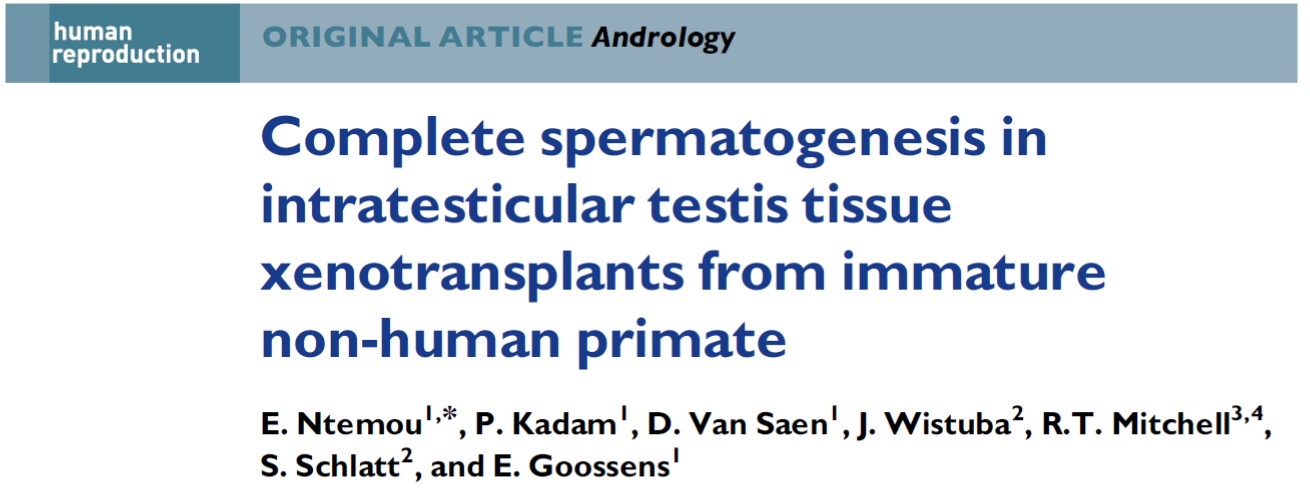Boys receiving gonadotoxic treatment (e.g. chemo- or radiotherapy) before puberty face the possibility of being infertile when they reach adulthood due to the loss of germ cells. As mature spermatozoa are not present, the only fertility preservation strategy currently offered involves the cryopreservation of immature testis tissue (ITT) containing spermatogonial stem cells (SSCs). Auto-transplantation of cryopreserved ITT has the advantage of retaining SSCs within their niche, providing an optimal microenvironment, and is therefore a promising approach to restore fertility. Although xenotransplantation of ITT has resulted in complete spermatogenesis in several species (e.g. mice, hamster, rabbit, bovine, horse, cat and dog), ITT has not been successful in human. Possibly the relatively short time that human fragments could be maintained in mice was the reason for not achieving full spermatogenesis. Therefore, Ntemou and colleagues designed a study using ITT from marmosets (Callithrix jacchus) in which testicular tissue matures much faster (puberty starts around the age of 11 months, whereas in humans it begins around the age of 12 years). In addition, similarities, including reproductive hormonal activity and germ cell differentiation, render the marmoset as a pre-clinical animal model for human testicular development [1, 2].
In this study, Ntemou and colleagues compared two potential transplantation sites over a long period and report for the first time complete spermatogenesis with generation of spermatozoa in marmoset transplants following intratesticular xenotransplantation of ITT.
Ntemou and colleagues obtained testis tissue pieces from two 6-month-old co-twin marmosets, stored them overnight at 4°C in cold Dulbecco’s Modified Eagle Medium (DMEM) and transplanted the fragments next morning either into the testicular parenchyma or under the dorsal skin of 4-week-old immunodeficient Swiss Nu/Nu mice. Afterwards, xenotransplants were retrieved at 4 and 9 months post-transplantation and analyzed by immunohistochemical stainings with regard to transplant survival and germ cell differentiation. Four months post-transplantation, 78% of the intratesticular transplants showed postmeiotic differentiation (round spermatids, elongated spermatids and spermatozoa). In contrast, in the ectopic transplants, spermatocytes (early meiotic germ cells) were the most advanced germ cell type present at 4 months and no transplants could be recovered after 9 months (not detectable or only interstitial cells and fibrosis were observed). However, complete spermatogenesis was observed in all recovered intratesticular transplants after 9 months, indicating a progressive spermatogenic development in intratesticular transplants between the two time-points. Due to ethical restrictions, the authors were not able to prove the functionality of the spermatozoa produced in the marmoset transplants, but fertilization competence of sperm derived from monkey testicular xenografts was confirmed previously [3].
In this study, Ntemou and colleagues demonstrated that the testicular parenchyma provides the required microenvironment (temperature regulation, growth factors and hormonal support) for germ cell differentiation and long-term survival of immature marmoset testis tissue. The results indicate progressive and sustained spermatogenesis over an extended period. Therefore, the authors hypothesize that the generation of sperm in human ITT xenotransplants may require a prolonged (more than 9 months) transplantation period, and suggest that future studies should focus on extending the xenotransplantation period. Furthermore, different potential transplantation sites with eligible temperatures as well as exogenous administration of FSH or human chorionic gonadotropin should be investigated to determine the mechanisms regulating spermatogenesis in ITT transplants. Taken together, ITT could be a potential fertility restoration strategy for patients with complete loss of germ cells due to chemo- and/or radiotherapy at a young age.
[1] Sharpe et al. 2000. ‘’Effect of neonatal gonadotropin-releasing hormone antagonist administration on Sertoli cell number and testicular development in the marmoset: comparison with the rat’’. Biol Reprod 62:1685-1693.
[2] Mitchell et al. 2008. ‘’Germ cell differentiation in the marmoset (Callithrix jacchus) during fetal and neonatal life closely parallels that in the human. Hum Reprod 23:2755-2765.
[3] Liu et al. 2016. ‘’ Generation of macaques with sperm derived from juvenile monkey testicular xenografts’’ . Cell Res 26:139–142.
Ntemou et al. 2019. “Complete spermatogenesis in intratesticular testis tissue xenotransplants from immature non-human primate.” Hum Reprod 34: 403-413.

